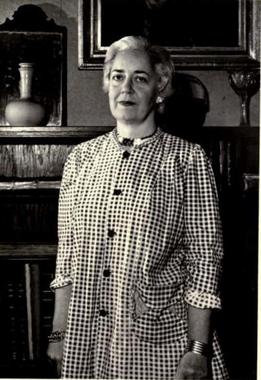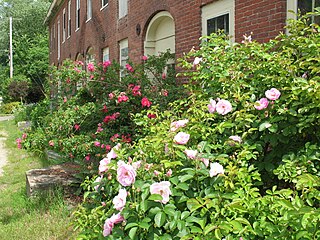History
The Grabhorn Institute was founded when Andrew Hoyem, the proprietor of the Arion Press (the successor to the Grabhorn Press), and the type foundry M&H Type, facing eviction from their location in San Francisco in 2000, confronted the logistical and financial problem of moving over 140 tons of metal type plus heavy iron and steel printing presses and typecasting and bookbinding equipment to a suitable new facility. The press and foundry comprised a complete, traditional bookmaking facility, including the last large-scale hot metal type foundry in the country.
Support raised by the Grabhorn Institute enabled Arion and M&H to relocate to the Presidio of San Francisco as a cultural tenant in April 2001. In recognition of its work to preserve the typecasting and letterpress printing operation, the Grabhorn Institute was designated by the National Trust for Historic Preservation as part of "the nation's irreplaceable historical and cultural legacy" under its Save America's Treasures program. [2]
The Grabhorn Institute received a California Heritage Council Award in 2002 for "preservation of the last fully functioning type foundry and integrated letterpress printing facility." [3]
Programming
Activities of the Grabhorn Institute include exhibits and lectures related to fine printing and book arts and an apprenticeship program to preserve the crafts of typecasting, letterpress printing, and bookbinding. It also conducts tours of the historic production facility, which includes the M & H Type foundry, established in 1915 with Monotype typecasting machines that came to San Francisco for the Panama–Pacific International Exposition; twelve letterpress printing presses; a bindery for hand bookbinding; and a large collection of rare typefaces passed down from the Grabhorn brothers and the noted San Francisco printer John Henry Nash.
According to Preservation, the magazine of the National Trust for Historic Preservation, "The collaboration among Arion Press, M&H Type, and the Grabhorn Institute is a model for preserving historic manufacturing equipment, keeping alive disappearing crafts, and printing beautiful artifacts—all in one enterprise." [4]

Letterpress printing is a technique of relief printing for producing many copies by repeated direct impression of an inked, raised surface against individual sheets of paper or a continuous roll of paper. A worker composes and locks movable type into the "bed" or "chase" of a press, inks it, and presses paper against it to transfer the ink from the type, which creates an impression on the paper.

American Type Founders (ATF) Co. was a business trust created in 1892 by the merger of 23 type foundries, representing about 85 percent of all type manufactured in the United States at the time. The new company, consisting of a consolidation of firms from throughout the United States, was incorporated in New Jersey.

A type foundry is a company that designs or distributes typefaces. Before digital typography, type foundries manufactured and sold metal and wood typefaces for hand typesetting, and matrices for line-casting machines like the Linotype and Monotype, for letterpress printers. Today's digital type foundries accumulate and distribute typefaces created by type designers, who may either be freelancers operating their own independent foundry, or employed by a foundry. Type foundries may also provide custom type design services.

The Museum of Printing (MoP), located in Haverhill, Massachusetts, is a museum dedicated to preserving the history of printing technologies and practices, the graphic arts, and their role in the development of culture and literacy.

Walter Samuel Haatoum Hamady was an American artist, book designer, papermaker, poet and teacher. He is especially known for his innovative efforts in letterpress printing, bookbinding, and papermaking. In the mid-1960s, he founded The Perishable Press Limited and the Shadwell Papermill, and soon after joined the faculty at the University of Wisconsin–Madison, where he taught for more than thirty years.

The Type Archive was a collection of artefacts representing the legacy of type founding in England, whose famous type foundries and composing systems supplied the world with type in over 300 languages. The Archive was founded in 1992 by Susan Shaw in Stockwell, South London. The Archive announced in mid-2022 that it would relinquish its building and return portions of its collections to other institutions.

Gudrun Zapf von Hesse was a German book-binder, calligrapher and typographer.
Fine press printing and publishing comprises historical and contemporary printers and publishers publishing books and other printed matter of exceptional intrinsic quality and artistic taste, including both commercial and private presses.

The San Francisco Center for the Book (SFCB) is a non-profit organization founded in 1996 by Mary Austin and Kathleen Burch in San Francisco, California in the United States. The first center of its kind on the West Coast, SFCB was modeled after two similar organizations, The Center for Book Arts in New York City and the Minnesota Center for Book Arts in Minneapolis.
Andrew Lewison Hoyem is a typographer, letterpress printer, publisher, poet, and preservationist. He is the founder and was the director of Arion Press in San Francisco until his retirement in October 2018. Arion Press "is considered the nation's leading publisher of fine-press books," according to the Minneapolis Star Tribune. Arion Press "carries on a grand legacy of San Francisco printers and bookmakers," according to Michael Kimmelman of The New York Times. Hoyem’s work in preserving the nation’s last typefoundry has been recognized by the National Trust for Historic Preservation.
Arion Press is an American book publishing company in San Francisco. Founded in San Francisco in 1974, it publishes limited-edition books illustrated by notable artists using letterpress equipment dating to the 1910s.

Bookbinding is the process of building a book, usually in codex format, from an ordered stack of paper sheets with one's hands and tools, or in modern publishing, by a series of automated processes. Firstly, one binds the sheets of papers along an edge with a thick needle and strong thread. One can also use loose-leaf rings, binding posts, twin-loop spine coils, plastic spiral coils, and plastic spine combs, but they last for a shorter time. Next, one encloses the bound stack of paper in a cover. Finally, one places an attractive cover onto the boards, and features the publisher's information and artistic decorations.
The Sacramento Book Collectors Club is a book club and publisher based in Sacramento, California. It was founded in 1939 and has been running as a non-profit organisation since 1954. The club houses around 10,00 books, and has published 18 new titles since 1942.
James Mosley is a retired librarian and historian whose work has specialised in the history of printing and letter design.

Jane Bissell Grabhorn (1911–1973) was an American artist, typographer, bookbinder, and printer.

Golgonooza Letter Foundry & Press, named after the city of art and imagination in the poetry of William Blake, is a printing press founded in Boston, Massachusetts, by partners Dan Carr and Julia Ferrari in 1979. The press moved to New Hampshire in 1982. It focuses on preserving the arts of letterpress printing, punch cutting, and bookbinding through the creation of handmade books as well as the education of both students and interns. Golgonooza Letter Foundry & Press and its subsidiary businesses Enitharmon Bindery and Trois Fontaines publishing are currently run by owner and co-founder Ferrari after the death of Carr in 2012.
Peter Rutledge Koch, also known simply as Peter Koch is an American letterpress master printer, artists' book maker and publisher, typographer, educator, author and book designer. Koch is internationally known for his fine press artists' books. Over the years he has published under a variety of imprints, including Black Stone Press; Peter and the Wolf Editions; Editions Koch; Hormone Derange Editions; and Peter Koch Printer and The REAL LEAD Saloon.

In letterpress printing, wood type is movable type made out of wood. First used in China for printing body text, wood type became popular during the nineteenth century for making large display typefaces for printing posters, because it was lighter and cheaper than large sizes of metal type.












